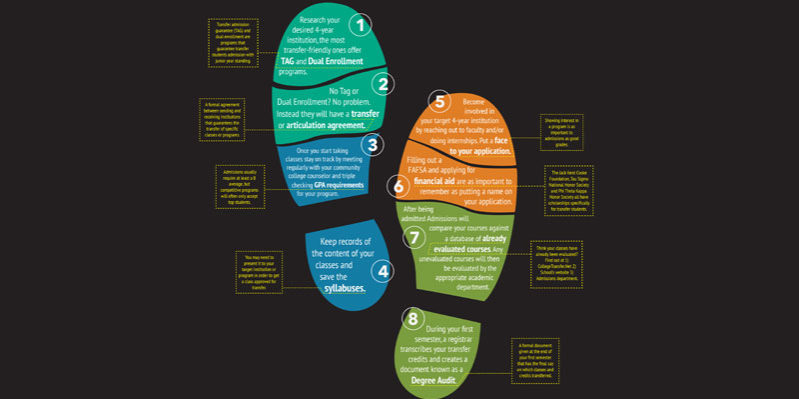
- Research your desired 4-year institution, the most transfer-friendly ones offer TAG and Dual Enrollment programs.
(Transfer admission guarantee (TAG) and dual enrollment are programs that guarantee transfer students admission with junior year standing.) - No Tag or Dual Enrollment? No problem. Instead they will have a transfer or articulation agreement.
(A formal agreement between sending and receiving institutions that guarantee the transfer of specific classes or programs.) - Once you start taking classes stay on track by meeting particularly with your community college counselor and triple checking GPA requirements for your program.
(Admissions usually require at least a B average, but competitive programs will often only accept top students.) - Keep records of the content of your classes and save the syllabuses.
(You may need to present it to your target institution or program in order to get a class approved for transfer.) - Become involved in your target 4-year institution reaching out to faculty and/or doing internships. Put a face to your application.
(Showing interest in a program is as important to admissions as good grades.) - Filling out a FAFSA and applying for financial aid are as important to remember as putting a name on your application. (The Jack Kent Cooke Foundation, Tau Sigma National Honor Society and Phi Theta Kappa Honor Society all have scholarships specifically for transfer students.)
- After being admitted admissions will compare your courses against a database of already evaluated courses. Any unevaluated courses will then be evaluated by the appropriate academic department. (Think your classes have already been evaluated? Find out at 1) CollegeTransfer.Net 2) School’s website 3)Admissions department.)
- During your first semester, a registrar transcribes your transfer credits and create a document known as a Degree Audit. (A formal document given at the end of your first semester that has the final say on which classes and credits transferred.)



